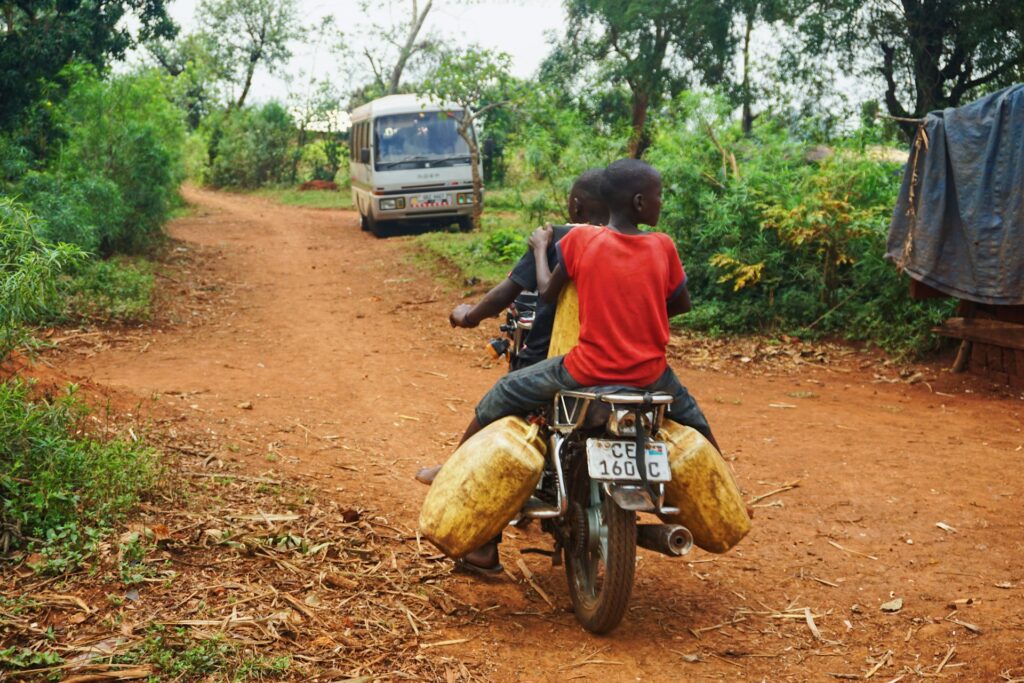Driving in Uganda is not for the faint-hearted more so if your route is the kind that is slippery on the rainy day. A few driving tips will come in handy to make your self guided Uganda trip a success. Here are some of the tips for driving on Ugandan slippery roads.
Check Car Tires
It is important to inspect the tires of the car before driving. Key issues in this regard include checking treads on all tires to ensure they are standard and can work on slippery roads.
Commonly there are two types of tires; offroad tires and highway tires. To have a smooth driving experience in Uganda, we recommend you hire a car that has offroad tires, not highway tires.
Clean Wind Shield
The windscreen must be clear for a better view with functioning screen wiper blades and washer solvent since driving on slippery roads on rainy days could result in mud falling on the windshield during the fight to maneuver the roads.
Also, take note that the washer fluid reservoir is full and the nozzles are clean and functioning correctly to flash well.
A 4×4 Car
Given the nature of roads and the terrain, it is advisable that you hire a 4×4 car for your trip. There are often two options of 4×4 Uganda car rentals, full-time four-wheel drive cars and part-time four-wheel drive cars.
The full-time four-wheel drive car is recommended. These usually have the option of engaging a low gear four-wheel drive gear.
Stay On the Main Road
Staying on the road that everyone is using. It is common to find something that looks like a detour while driving in Uganda. Though you can see the main road open without any signpost, always follow the route that the other drivers are using to avoid getting stranded in damaged roads.
Avoid Driving at Night
If you rent a car in Uganda, it is recommended to drive during the day to avoid unnecessary risks before your next destination, during the day, it is easier to get help from other road users unlike at night when people are likely to abandon you in order to get to their next destination.
You Need a Fully Functional Battery
A car battery is a very important component of the car and thus be fixed and fully functional before setting off. Ensure it is well maintained, and all terminals are fixed and working to avoid any issues.
Pack the Necessary Tools in Case of a Breakdown
When you rent a car in Uganda for self-driving safaris in our national parks, it is food for thought for you not to forget the major tools or any technical gadgets that can help you along the way for personal rescue;
The most important tools include a Hydraulic Jerk and spare tires (flat tires are common on muddy roads due to friction when cars struggle to maneuver), the Global Positioning System (GPS) helps in locations and directions even in very remote areas and also offers optional routes in case of congestion due to breakdown and Tow Strap or a Winch which is fixed on either car for towing in case of a breakdown. A winch is an electronic device where the car pulls itself by stationing a tree trunk or cramped to another car.
Other essential tools include pliers, spanners, hammers for minor repairs and fixes in case there are simple car failures, and fire extinguisher as some cars may experience short circuits or even car accidents that may cause the car to catch fire; the fire extinguisher helps you to stop the fire.
Lock Your Wheels
When you drive in remote areas like in the rolling hills, muddy slippery routes, always have your car wheel locks closed so that in case you get stuck and the locks can’t display because the tyres are covered, you can easily shift your 4×4 gear leaver of place that 4wd button.
Ensure Good Brakes
For a better drive on slippery roads in Uganda, you need to have your car in a good condition in relation to braking system.
Inspect and ensure the car brake pads, calipers and discs are steadily functional to avoid the any accidental problems.
Have an Object Free Dashboard
Clear all the empty bottles, cups and drinking bottles from the dashboard because they may drag into peddles and this may end into collusions due to brake failure.
Avoid Using Phones While Driving
Don’t divide attention with your phone while driving as this has been revealed as one of the causes for most accidents on the roads.
In case you must communicate, use hands free systems but better stay away from the phone and or otherwise keep in silent mode to avoid distraction.
Keep a Distance from Other Drivers
It is advisable to keep a reasonable distance from cars in front of you so that you can have an ample space to avoid collusions in case emergency that could come from instant brakes that could be a result of bad roads, potholes etc.
In otherwise don’t drive bumper to bumper. You are also reminded that in Uganda we keep left, so keep it mind to be safe.
Rest before Your Drive
Every driver is accustomed to taking enough rest before starting a drive, most especially if you have a very long distance to cover.
Avoid driving when you are drowsy or else hire a car with a driver and you enjoy your road trip at leisure
Check the Engine Coolant
There needs to be a full-time cooling system whenever the engine is on combustion. Therefore, check and monitor your radiator and refill the coolant if it’s at low levels to avoid overheating and engine crushing in tough engagements.
A First Aid Kid (CPR)
Remember to pack you first aid Kit whenever you book Uganda car rental for self-drive trips as this helps you in accidental instances; either minor or major.
Fix Your Belts
It’s a mandate that every time before you start your car engine, you are advised to fix the seat belt first; it saves life in bad situations especially when cars rollover in dangerous roads.
AREAS MOST affected roads during RAINY SEASONS in Uganda
Some of the most slippery regions in Uganda to take note to take of are; the southwestern when you are heading to Uganda’s national parks such as Bwindi National Park, Queen, Elizabeth National Park, Lake Mburo, the northeastern side especially the Kidepo National Park Routes and most of the rural road Upcountry.
With such tips, the best way to enjoy self-drive experience in Uganda is to generate a personal itinerary to follow as this helps a have a better calculated distance in terms of fuel.
In a nutshell, following the above safety tips can save lives and you can also have a memorable safe drive when you consider all the defensive driving techniques.

